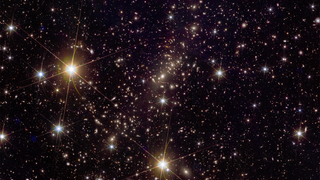UMass Amherst Astronomer Leads International Effort to Unravel Evolutionary Secrets of the Universe
The European Space Agency (ESA) and the Euclid Consortium—a collaboration of 2,000 researchers from 300 institutions in 15 European countries, the U.S., Canada and Japan—recently released the first stunning images from the Euclid space telescope, launched in July 2023. Euclid’s mission is to trace the hidden web-like foundations of the cosmos, map billions of galaxies across more than one-third of the sky, explore how our Universe formed and evolved over cosmic history and study the most mysterious of its fundamental components: dark energy and dark matter. The University of Massachusetts Amherst’s astronomy department is leading the effort on behalf of the Euclid Consortium to understand the earliest days of the universe, and how we got to where we are today.
For John Weaver, a postdoctoral researcher in astronomy at UMass Amherst and the lead author of one of 10 papers describing Euclid’s findings, the satellite is helping him to look at things that shouldn’t exist—but do.
“We see galaxies in the nearby universe that have surprisingly large numbers of stars—in fact, they have an uncomfortable number of them, more than we think they should. Where did all these stars come from? Euclid is now showing us superbright galaxies in the early universe less than a billion years after the Big Bang — and they are much brighter than they should be, too. I want to find out if these superbright, very distant galaxies eventually evolve into today’s supermassive galaxies.”
The light from these galaxies took some 13 billion years to reach us, meaning that we see them as they were in their infancy shortly after their formation. Essentially, Weaver and his colleagues are able to look back in time.
A single Euclidimage contains both old supermassive galaxies that have ceased forming their stars and distant young galaxies forming lots of stars. It’s like being able to study an ancient fossil and a live dinosaur, all at the same time. “Is it plausible,” Weaver wonders, “that these superbright galaxies grow into the supermassive fossils?”
Unprecedented results
The images obtained by Euclid are at least four times sharper than those taken by ground-based telescopes. They cover large patches of sky unrivalled in scale, looking far into the distant universe using both visible and infrared light. Image
“It’s no exaggeration to say that the results we’re seeing from Euclid are unprecedented,” says ESA Director of Science Carole Mundell. “Euclid’s first images, published in November, clearly illustrated the telescope’s vast potential to explore the dark universe, and this second batch is no different.
“The beauty of Euclid is that it covers large regions of the sky in great detail and depth and can capture a wide range of different objects all in the same image – from faint to bright, from distant to nearby, from the most massive of galaxy clusters to small planets,” Mundell continues. “We get both a very detailed and very wide view all at once. This amazing versatility has resulted in numerous new science results that, when combined with the results from Euclid’s surveying over the coming years, will significantly alter our understanding of the universe.”
While visually stunning, the images are far more than beautiful snapshots; they reveal new physical properties of the universe thanks to Euclid’s unique observing capabilities.
Euclid produced the entire set of Early Release Observations in just a single day, revealing over 11 million objects in visible light and 5 million more in infrared light. Careful measurements of their light has resulted in significant new science.
“Euclid demonstrates European excellence in frontier science and state-of-the-art technology, and showcases the importance of international collaboration,” says ESA Director General Josef Aschbacher. “The mission is the result of many years of hard work from scientists, engineers and industry throughout Europe and from members of the Euclid scientific consortium around the world, all brought together by ESA. They can be proud of this achievement – the results are no small feat for such an ambitious mission and such complex fundamental science. Euclid is at the very beginning of its exciting journey to map the structure of the universe.”

